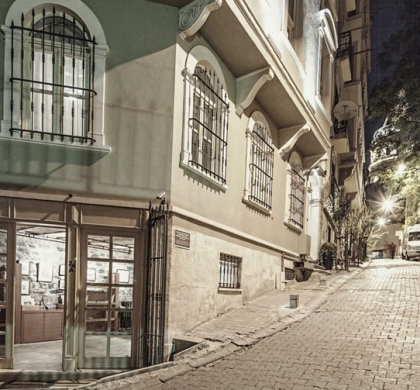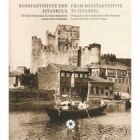Buy or gift a stand-alone digital subscription and get unlimited access to dozens of back issues for just £18.99 / $18.99 a year.
Please register at www.exacteditions.com/digital/cornucopia with your subscriber account number or contact subscriptions@cornucopia.net
Buy a digital subscription Go to the Digital EditionMax Fruchtermann (1852 –1918) was the publisher who took the postcard to Turkey and thereby took Turkey to the world. His cards sold by the million. Mert Sandalcı – historian, archivist and librettist – has assembled thousands of these cards into three mammoth volumes. Elizabeth Meath Baker leafs through their pages.
When Max Fruchtermann wrote to the Imprimerie Emil Pinkau in Breslau to order his first print run of picture postcards in 1895, it must have been with some excitement: he would be the first to bring what had become a European craze to the Ottoman capital. Fruchtermann was a child of two huge, declining but multi-ethnic empires: born on the eastern edge of Austro-Hungary to German Protestant parents in 1852, he had come to the heart of the Ottoman Empire in 1867, opening a frame-shop on Yüksekkaldırım two years later when he was just 17.
In 1895 long-distance international travel was just taking off as a pastime: Constantinople, the most romantic destination, on the threshold of the East, had suddenly moved nearer. “The entire continent turns eastward,” wrote Victor Hugo in the prologue to Les Orientales. In 1883, passengers on the first Express d’Orient from Paris to Constantinople had been advised to carry guns and rifles, just in case, and were also forced to disembark at Varna for a choppy boat crossing of the Black Sea. But 1889 saw the first “through” train, which called at Strasbourg, Munich, Vienna, Budapest and Bucharest, taking a mere seventy hours; the Compagnie des Wagons-Lits opened the Pera Palas Hotel in 1895 to accommodate its passengers in suitable comfort…
Photographs of landscapes, important buildings, interesting local sights and characters had for some time been available for these new tourists to buy as souvenirs from galleries in the city’s European quarter, close to their hotels. But the photographers – Sébah and Joaillier, Kargopoulos, Abdullah Frères – had become rich and grand, some being commissioned by the Sultan to record such things as new schools and railway stations around the empire, and to take his portrait, so their work could be expensive…
Fruchtermann must have struck some kind of deal with the grand photographers, for the postcards he printed featuring their work sold cheaply, so that everyone, tourists and locals, could afford to buy them. The first known trial cards went on sale in July and August 1895, and by Christmas that year Fruchtermann had brought out his first series. Enthusiasts rapidly bought up series after series, both to send to (and as often to exchange with) friends, and to accumulate into albums. It proved hard for Fruchtermann to keep up. He created a key position for himself in the swiftly developing market he had initiated. Then, as now, collectors divided into those interested in stamps, franking or postmarks, and those who collected cards for their intrinsic interest. As a dealer in both cards and stamps, Fruchtermann dominated the trade for both groups.
In 1897 he began to publish in colour. The earliest examples were probably painted by hand in the shop (a telltale sign is watercolour paint that has seeped through to the back of the card). The technical development of the cards closely followed progress in photo and litho printing. An extraordinary range of topics was covered, and millions of Fruchtermann cards were sold.
Opening the massive three-volume catalogue of Max Fruchtermann’s postcards so lovingly put together by archivist and historian Mert Sandalcı over years of patient detective work, every aspect of these fragile documents is of interest. Each card is a richly textured fragment of history. Here are cards in French, German, Russian, Italian, English, Ottoman Turkish, Arabic and Persian. Each one may have travelled further than the individual who first sent it. Originally often traded on a barter system, with a value that quickly surpassed their original price of one kuruş, two pfennigs, or two centimes, they became a currency in themselves. Because at first the backs of the cards were used only for the address, the messages are written over the pictures. Often they concern the exchange of postcards, but there are also tantalising vignettes of people’s lives – travellers’ tales, thanks, congratulations, diffident lovers’ greetings. Their size imposes a brevity, immediacy and informality which must have felt quite new: a 19th-century email.
Fruchtermann died a broken man in 1918, destroyed by depression and drink. The empires that had nurtured him, together with the huge success and fortune he had amassed, had been obliterated by war. His son carried on the business, after a fashion, into the Sixties, but it went into liquidation in 1966. An archive of next to 600,000 cards was sold to a secondhand dealer for a song…
Sandalcı’s hunt for every known Fruchtermann card began, as it well might, in the Charing Cross Road. A notoriously taciturn dealer, a Mr Drumm, was offering the usual stuff for the passing trade, and was surprised when the £80 he asked for something more interesting was handed over without a word. Sandalcı earned himself a trip to the dealer’s country house, and a tour of his collection which culminated, after several hours, in a climb up a ladder to an attic packed from floor to ceiling. Weaving their way through, they arrived at a cupboard where the dealer pulled out a drawer crammed with Ottoman cards. He invited Sandalcı to take his pick and name a price. The very first card he pulled out was extraordinarily valuable: one written and sent by Fruchtermann himself. Embarrassed, Sandalcı offered to put it back, but his offer was firmly refused - £20 would do, wouldn’t it? Astonished, Sandalcı accepted what is one of the crucial pieces in his collection…
The pots of Alev Ebuzziya Siesbye have an ideal serenity and timeless beauty, as visitors to her retrospective in Istanbul have discovered. But their cool simplicity belies the passion that goes into creating them. Alistair McAlpine met the artist in Paris.
Robert Ousterhout, who fell in love with the Kariye Camii, the Church of the Chora, 25 years ago. Here he makes an impassioned case for preserving this 14th-century masterpiece.
Brian Mathew pays tribute to the late Turhan Baytop, Turkey’s pre-eminent botanist
Most fast food is heavy, greasy and bad for your health. Güllaç pancakes, by contrast, are beautiful organza-thin leaves, light as a feather and made from the simplest ingredients. What’s more, they keep for an age. Berrin Torolsan sees the best gullaç in the making
Both were ambitious men with a penchant for poetry who suffered extremes of fortune. David Barchard charts the ties between two dominant figures in nineteenth-century Turkey, the British Ambassador Stratford Canning, and the Ottoman sultan Mahmut II
Wine is now the most popukar alcoholic drink on the planet, says Esat Ayhan, ‘and we in Turkey are benefitting from this positive wind.’ Owner for the past twenty-two years of a fashionable Cihangir şarküteri, stocking everything from De Cecco pasta to bacon and paté, Esat Bey took the opportunity to expand its renowned La Cave wine section into an entire floor devoted to the grape.
Francis Beaufort’s epic 1812 survey of Turkey’s southern coast and its classical sites sparked a European treasure hunt. It also very nearly cost him his life. By Nicholas Courtney with photgraphs by Kate Clow and James Mortimer
Wild apples, with their pink or white blossom in spring, are still a common sight in Turkey. They are collected in the autumn, when they ripen, and preserved for winter.
More cookery features













Cornucopia works in partnership with the digital publishing platform Exact Editions to offer individual and institutional subscribers unlimited access to a searchable archive of fascinating back issues and every newly published issue. The digital edition of Cornucopia is available cross-platform on web, iOS and Android and offers a comprehensive search function, allowing the title’s cultural content to be delved into at the touch of a button.
Digital Subscription: £18.99 / $18.99 (1 year)
Subscribe now